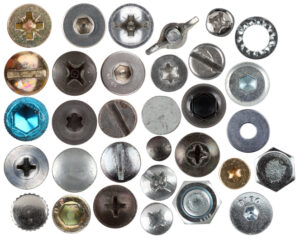When you’re trying your hand at do it yourself projects at home, it can be difficult to know which tools are right for the job. Some might even say that walking down the aisles of a big-box hardware store makes them feel like they have a screw or two loose! Here are some tips on picking the right screw and screwdriver for the job and the different types of screws available.
Screw Heads
A combination screw head will work with a slotted screwdriver and a Phillips head screwdriver, but a slotted screwdriver can easily slip out of this screw head. Phillips screwdrivers offer you lots of torque, but the pointed tip can cause it to slip out of the screw head when turning. A square head screw allows the screwdriver to have the least amount of slipping with the greatest amount of positive torque.
Brass Screws
Brass screws come in a large variety of sizes. Small screws, like number 0 or number 1, are useful for attaching decorative hinges for your front door. These screws are known as flathead wood screws. Ensure that you have the proper size screwdriver before attempting installation, as a screwdriver that is too big will strip out the heads.
Wood Screws
Wood screws differ from drywall and sheet metal screws in many ways when it comes to wood projects. Sheet metal screws have threads running from the top of the screw to the bottom. When connecting two wood pieces, the threads can prevent the two pieces from tightly connecting and cause a gap. Drywall screws do not have any threads at the top. Instead, they have thin shanks with separated threads that can cut through material quickly without splintering the wood. Wood screws do not have threads at the top, so they can pull wood together quickly and tightly.
See a screw with a gullet at the end that looks similar to a drill bit? These screws cut as they enter the wood, making their own pilot hole as they go along. These screws will do the work of the drill bit and reduce the chance of splitting or splintering the wood as you drive the screw in.
Metal Screws
Machine screws without a point are designed to go into a machined piece, similar to a nut. They are not typically used with wood, but they could work in a pinch. A lag bolt has a hex head and is ideally installed with a ratchet. Lag bolts are great for holding pieces of metal to pieces of wood. Make sure you drill a pilot hole before screwing in a lag bolt, as they have large heads that could split the wood.
The Right Screws for the Right Job at the Right Price
Fisher Lumber and Hardware has served homeowners and contractors in the Maryland, Washington, D.C., and Northern Virginia areas since 1894. We have excellent lumber, all of the building materials you need, top-notch tools, and the expertise to help you pick the right supplies for your project. Give us a call at 301-424-6500 or visit us online for more information. To see more tips for your DIY project, visit us on Facebook, Pinterest, Google+, Houzz, and Twitter!

